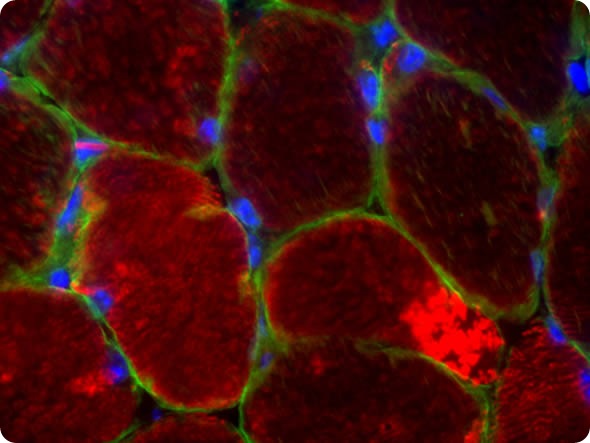A health supplement used by bodybuilders could be the key to treating a life-threatening muscular dystrophy affecting hundreds of Australian children, new research shows.
The amino acid L-tyrosine had a “rapid and dramatic impact” on Nemaline Myopathy (NM) in laboratory tests on mice, significantly improving symptoms of the muscle-wasting disease, medical researchers from the University of New South Wales (UNSW) found.
Trials showed that consuming L-tyrosine could significantly improve muscle strength and mobility in NM, raising the possibility it also could be effective in a range of other muscle-wasting diseases. L-tyrosine is readily available in health food shops for less than $30 and is used as a body building supplement and as a memory booster.

This is an image of a section taken from a muscle that has nemaline myopathy. The bright, circled structures are the nemaline rods which are dense accumulations of proteins within the muscle cells. The nemaline rods build up in the muscle cells and interfere with the contraction of the muscle. This is a fluorescently labeled image.
There is currently no cure for NM (or Rod Myopathy) – the most common congenital muscle disease – which causes muscle weakness of varying severity in an estimated 500 Australian children.
Children with NM experience delayed motor development and weakness in the arms and legs, trunk, throat and face muscles. The condition can lead to difficulties breathing and moving and, in its severest form, can cause death.
A team of scientists led by Professor Edna Hardeman, from UNSW’s Neuromuscular and Regenerative Medicine Unit, were able to test the efficacy of the supplement after creating – for the first time – a genetically modified mouse which display the same genetic changes found in children with NM.
“These mice and have a remarkably similar disease profile to the children, with many of the animals dying young,” Professor Hardeman said.
After feeding the mice the L-tyrosine, the team observed improvements in muscle strength, increased mobility and a reduction in a range of muscle pathologies.
The findings will now be used as the basis for a clinical trial to test L-tyrosine’s ability to alleviate symptoms in children.
“This is the first clear demonstration that L-tyrosine supplements can significantly reduce both the clinical and pathological features of NM,” Professor Hardeman said.
“L-tyrosine is readily available, it is easy to administer and our data suggest that long-term use is relatively safe,” Professor Hardeman said.
“What’s more, the rapid and dramatic impact of L-tyrosine in NM mice also raises the possibility the supplement may be beneficial for dystrophy patients and other muscle degenerative conditions.”
Other team members included Dr Mai-Anh Nguyen and Josephine Joya from UNSW’s School of Medical Sciences. The study was funded by the Australian National Health and Medical Research Council
The findings are published online in the journal Brain.
About Nemaline Myopathy:
Nemaline Myopathy is one of 40 neuromuscular diseases covered by the Australian Muscular Dystrophy Association, and was first identified in 1958 by an Australian physician, Dr Douglas Reye. It was originally named ‘rod myopathy’ because of the presence of distinct rod-like inclusions in sufferers’ skeletal muscle fibers.
NM has an estimated incidence of 1:50,000 live births. However, it may be more common in some populations, with some studies suggesting an incidence of 1:500 in the Amish community.
People with NM have muscle weakness (myopathy) throughout the body, but it is typically most severe in the muscles of the face, neck, and limbs. This weakness can worsen over time. Affected individuals may have feeding and swallowing difficulties, foot deformities, abnormal curvature of the spine (scoliosis), and joint deformities (contractures).
Most people with NM are able to walk, although some affected children may begin walking later than usual. As the condition progresses, some people may require wheelchair assistance. In severe cases, the muscles used for breathing are affected and life-threatening breathing difficulties can occur.